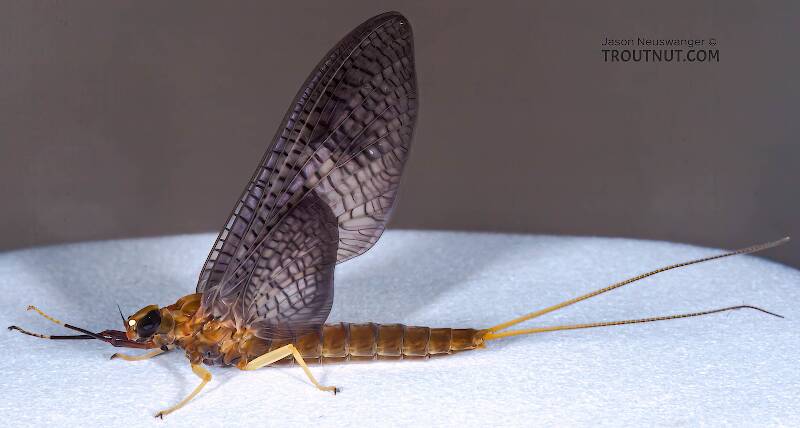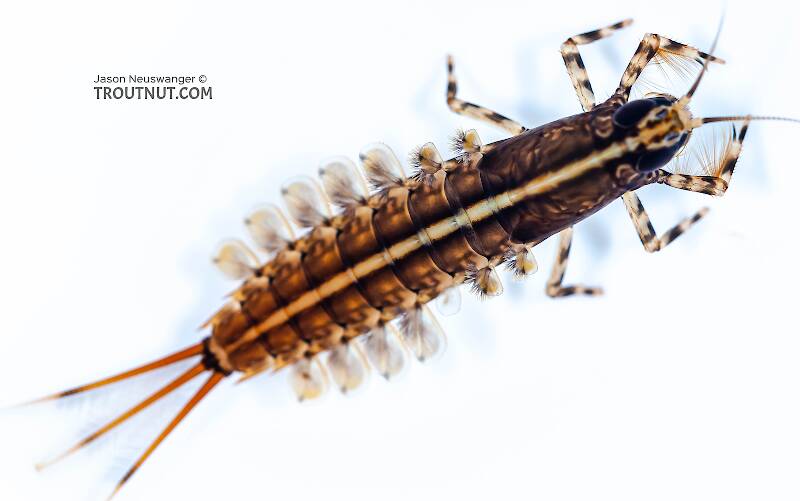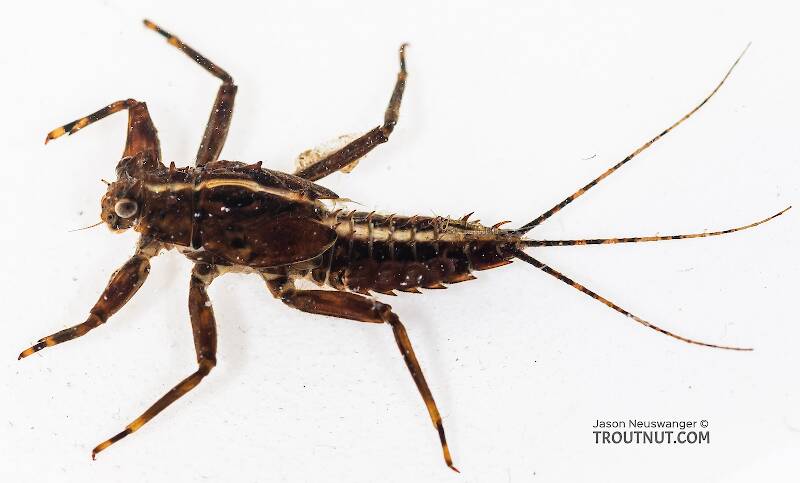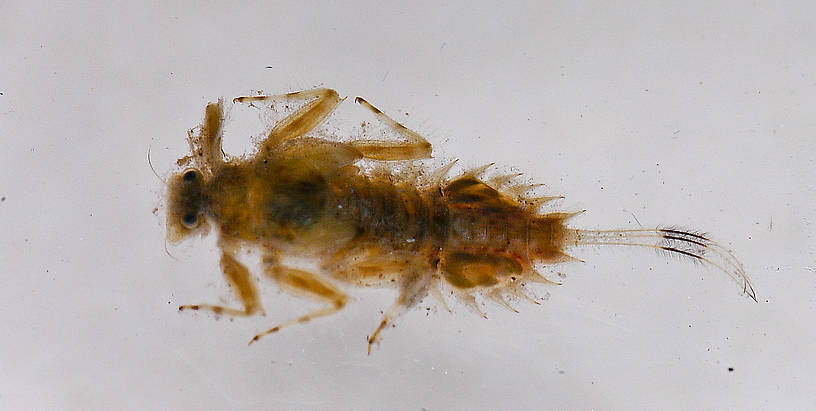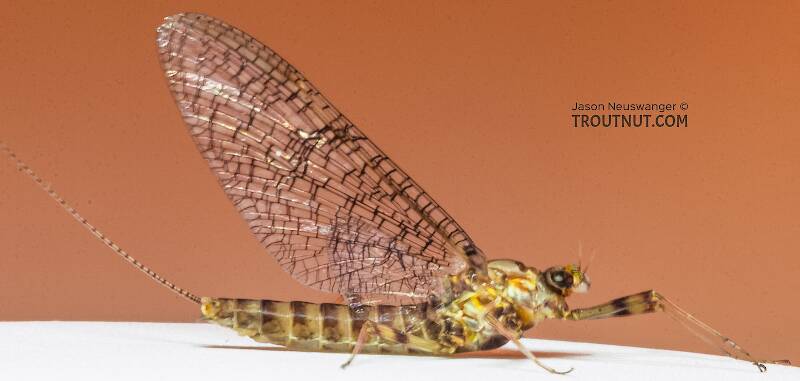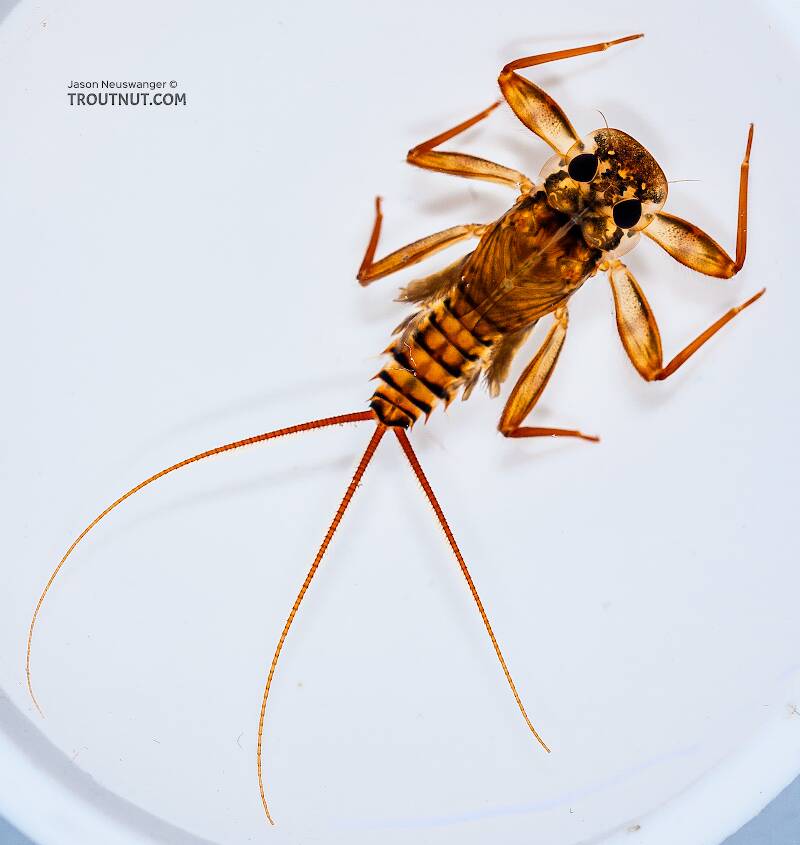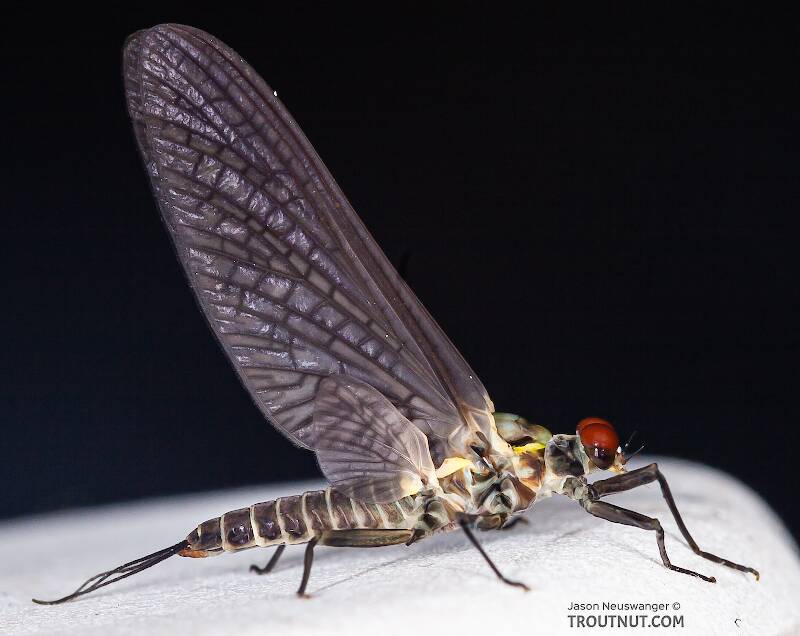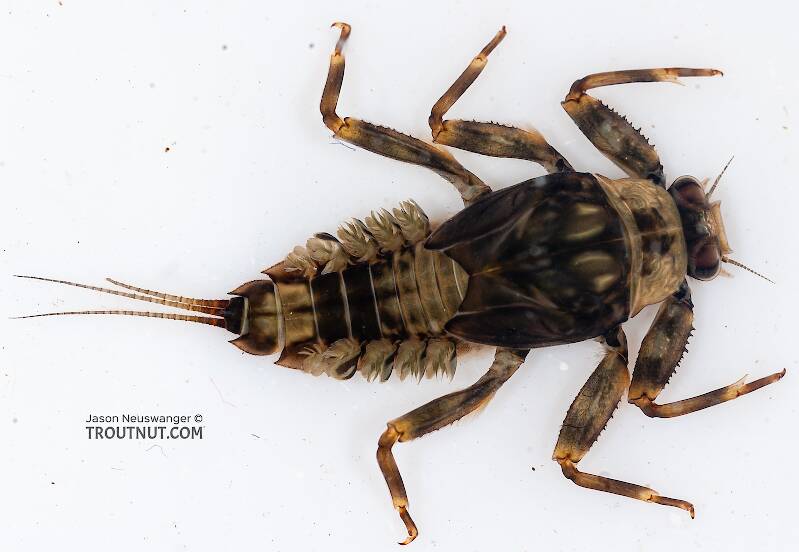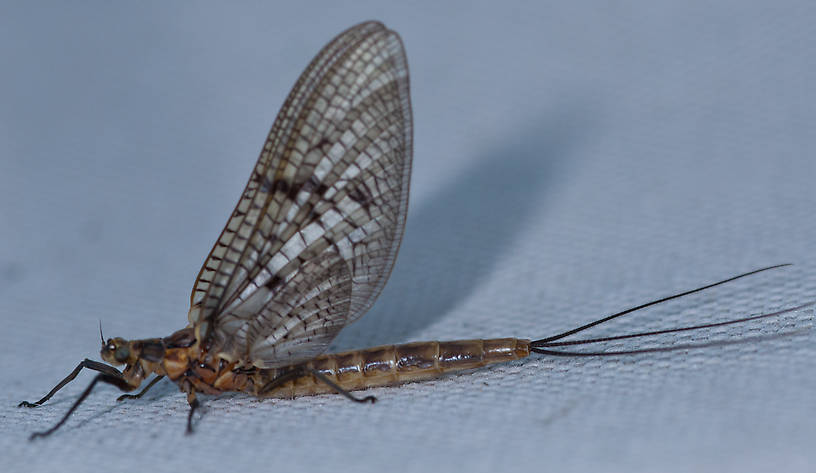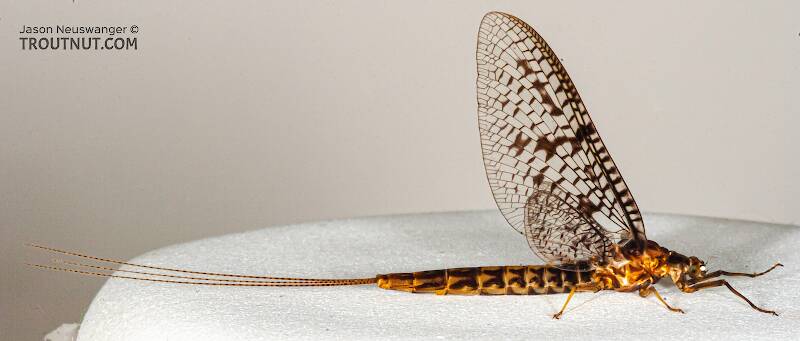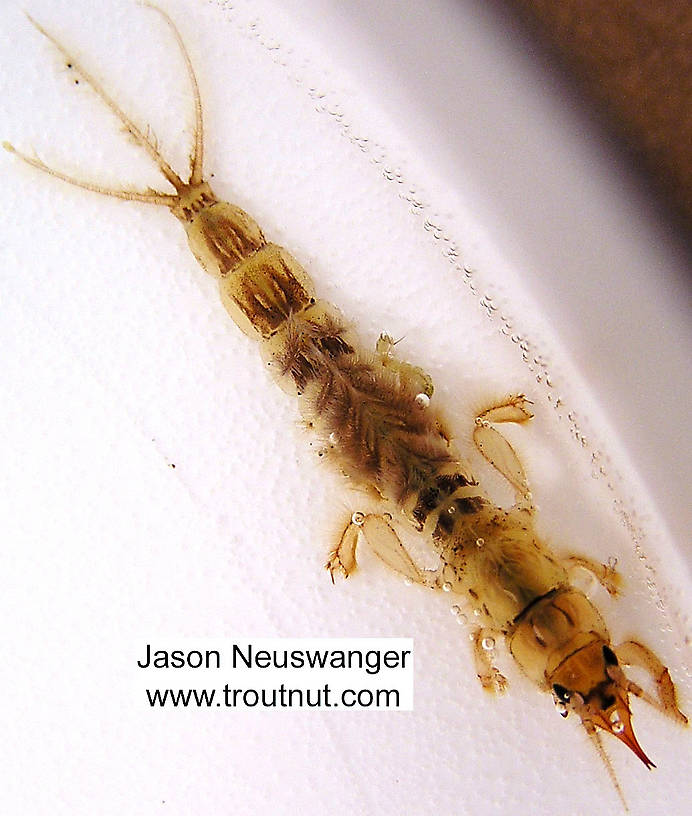
Hex Mayflies
Hexagenia limbata
The famous nocturnal Hex hatch of the Midwest (and a few other lucky locations) stirs to the surface mythically large brown trout that only touch streamers for the rest of the year.
Featured on the forum

Troutnut is a project started in 2003 by salmonid ecologist Jason "Troutnut" Neuswanger to help anglers and
fly tyers unabashedly embrace the entomological side of the sport. Learn more about Troutnut or
support the project for an enhanced experience here.
Great Red Spinners
Like most common names,"Great Red Spinner" can refer to more than one taxon. They're previewed below, along with 15 specimens. For more detail click through to the scientific names.
Mayfly Species Isonychia bicolor
These are sometimes called Great Red Spinners.
This is by far the most important species of Isonychia. Many angling books once split its credit with the species Isonychia sadleri and Isonychia harperi, but entomologists have since discovered that those are just variations of this abundant species.
See the main Isonychia page for more about these intriguing mayflies.
See the main Isonychia page for more about these intriguing mayflies.
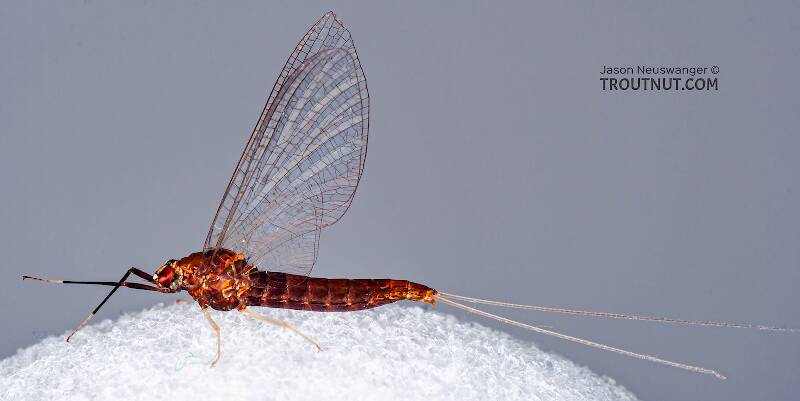
I collected this female together with a male.
See 16 more specimens...
Mayfly Species Drunella grandis
These are sometimes called Great Red Spinners.
This species (or rather group of subspecies), together with Drunella doddsii, make up the famous Western Green Drake hatches. They are widespread throughout the vast Western region and can be abundant enough in many locations to provide world class angling.
It hasn't been all that many years since Western traditions and entomological "facts on the ground" began to influence the angler's lexicon heavily dominated by Eastern writers. Their initial reporting after visiting the region first popularized the phrase "Rocky Mountains answer to the popular Green Drakes of the East". This led to a false impression that lingers to this day. The reality is these giants of their family have abundant populations all over the West with no counterpart in the East, and the West does have abundant hatches of comparable Ephemeridae. The Western tradition of naming outsized Mayflies "Drakes" is the reason for what many consider a misnomer by giving it the same common name as the legendary Ephemerid of the East and surely contributed to confusion for anglers unconcerned with such subtleties.
It hasn't been all that many years since Western traditions and entomological "facts on the ground" began to influence the angler's lexicon heavily dominated by Eastern writers. Their initial reporting after visiting the region first popularized the phrase "Rocky Mountains answer to the popular Green Drakes of the East". This led to a false impression that lingers to this day. The reality is these giants of their family have abundant populations all over the West with no counterpart in the East, and the West does have abundant hatches of comparable Ephemeridae. The Western tradition of naming outsized Mayflies "Drakes" is the reason for what many consider a misnomer by giving it the same common name as the legendary Ephemerid of the East and surely contributed to confusion for anglers unconcerned with such subtleties.
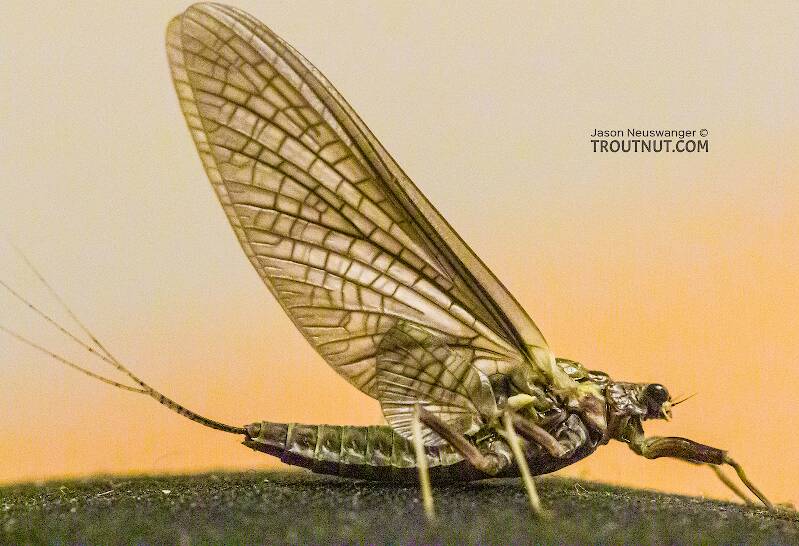
I collected this specimen while away from all my good photography equipment except the camera and one of my macro lenses, so I made do. The lighting is from lamps in a hotel room, so it was hard to edit for really true colors, but I tried to get as close as possible. The body was 13 mm long, wing 19 mm long.
See 10 more specimens...
Mayfly Species Timpanoga hecuba
These are sometimes called Great Red Spinners.
Timpanoga hecuba is not abundant enough, and its emergence not concentrated enough to provide great hatches, but where it is locally abundant it creates fishable action because of its large size. This species seems subject to substantial fluctuations in population densities, possibly in relation to the amount of silted habitat they prefer. When silt builds up in drought years, their numbers appear to increase. It is the largest species in the Ephemerellidae family, often rivaling Drunella grandis (Western Green Drake) in length but appearing even stouter due to its dramatic lateral abdominal spines. It contains two subspecies. See the Timpanoga genus hatch page for details.
Anglers call them by a confusing array of names, although many fly shops have fortunately started to clear things up by rightly calling them Hecubas. Great Red Quill and Western Red Drake seem fairly descriptive, and some refer to them as Giant Dark Hendricksons. A fly shop serving Yellowstone out of Gardiner, Montana calls them Drake Mackerels in their hatch chart.
Anglers call them by a confusing array of names, although many fly shops have fortunately started to clear things up by rightly calling them Hecubas. Great Red Quill and Western Red Drake seem fairly descriptive, and some refer to them as Giant Dark Hendricksons. A fly shop serving Yellowstone out of Gardiner, Montana calls them Drake Mackerels in their hatch chart.
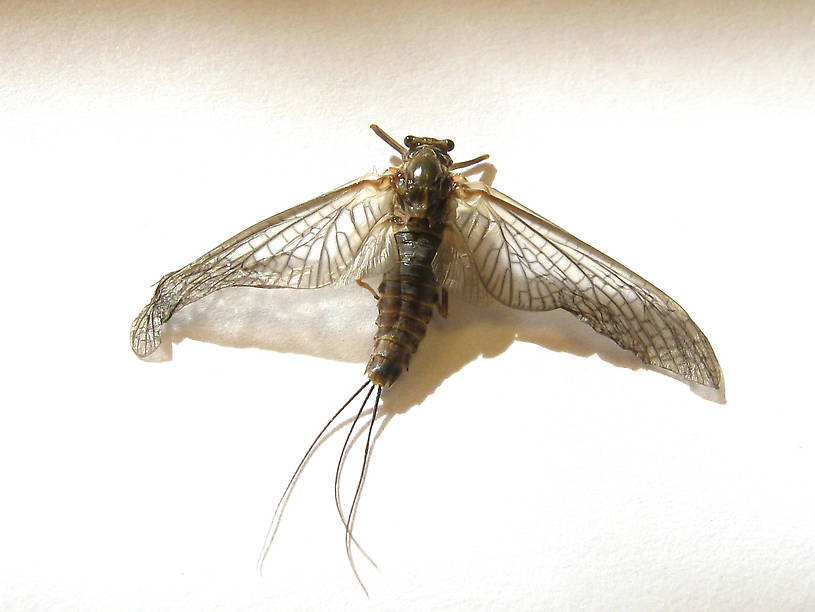
This specimen is 14 mm. Technically this is the subspecies T. h. hecuba. The Cascades, Sierras and further West is where the other subspecies, T. h. pacifica is found. The Great Basin seems to have formed a barrier preventing any overlap in their distribution.
See 1 more specimen...
Mayfly Species Stenonema vicarium
These are sometimes called Great Red Spinners.
In the East and Midwest this is one of the most important hatches of the Spring. They are large flies which emerge sporadically, making for long days of good fishing.
This species contains the two classic Eastern hatches formerly known as Stenonema vicarium and Stenonema fuscum, the "March Brown" and "Gray Fox." Entomologists have discovered that these mayflies belong to the same species, but they still display differences in appearance which the trout notice easily. Anglers should be prepared to imitate both types.
This species contains the two classic Eastern hatches formerly known as Stenonema vicarium and Stenonema fuscum, the "March Brown" and "Gray Fox." Entomologists have discovered that these mayflies belong to the same species, but they still display differences in appearance which the trout notice easily. Anglers should be prepared to imitate both types.
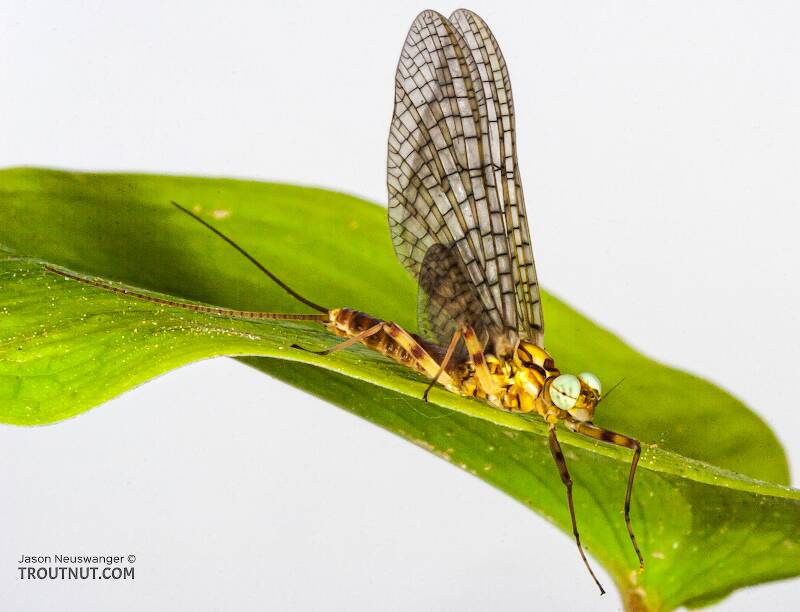
I collected this mayfly on the same trip as a female of the same species. After these photos it molted into a spinner. This is the form of Stenonema vicarium which anglers call the "Gray Fox."
See 17 more specimens...
Mayfly Species Drunella doddsii
These are very rarely called Great Red Spinners.
This species together with the Drunella grandis sub-species make up the Western Green Drake hatch. Besides being smaller, the adults are difficult to tell apart from it's larger siblings; but D. doddsi nymphs have a few peculiar traits that set them apart. D. doddsi looks much thicker in the thorax, has a flat frontal head margin and a unique oval disk-like ring of hairs on its ventral surface. However, There are very few differences between the habits of these two species, and they are almost always discussed together in fly fishing books, so for many of the characteristics of doddsii, refer to the Drunella grandis page.
See 10 more specimens...
Mayfly Species Ephemera simulans
These are very rarely called Great Red Spinners.
The Brown Drakes are a favorite hatch of many in the Midwest, and they make a good showing on localized waters across the country. They are usually the first in a series of big drakes which bring large trout to the surface at twilight and into the early hours of the night. The experience can be much like fishing the Hexagenia limbata hatch, except that the nymphs seem to emerge from slightly more wadeable, sandy bottoms instead of the boot-sucking mud underlying the best Hex water. It will draw big trout out from the depths of a big pool to feed in the shallow tailout after dark.
See 12 more specimens...



